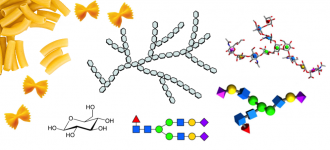
Tuesday, January 29, 2019 - 17:45

“Why you should love carbohydrates and sugar”- changing our (negative) perception of sugars
When you hear the words “carbohydrates” or “sugars”, what comes to mind? To name a few examples: unhealthy diets, diabetes, obesity, the sugar tax, low carb diets and the list goes on. There is nothing positive to say about carbohydrates and this is because in our modern world carbohydrates are generally perceived as the “public enemy number one”. The problem with this negative attitude is that sugars and carbohydrates are umbrella terms used to classify a huge family of molecules that play a massive role in all aspects of life, in terms of fueling our bodies as well as playing a part in the way our cells interact and function. Learning more about these molecules can give us a greater understanding of what their role is both in our diet and our health, and can help us realise that there is no life without carbohydrates.
The first lesson to learn is that our bodies actually do need carbohydrates to function, in the form of glucose that we introduce through our diet. Carbohydrates are complex molecules made up of smaller units called monosaccharides. Glucose is a monosaccharide that can be cut-off from larger carbohydrates, such as starch, by enzymes in our digestive system and processed by our livers through a mechanism called glycolysis. This series of enzymatic reactions produces per unit of glucose two molecules of Adenosine Triphosphate (ATP), which is the energy currency of our cells. Without ATP our cells would not be able to function, so we need to supply our bodies with enough glucose for our cells to keep going and ultimately to keep us alive.
So why do carbohydrates have such a bad reputation when it comes to food? Well it depends on what kind of carbohydrates we are introducing into our bodies. The simpler the construction of carbohydrates, the easier it is to break them down. If we eat a lot of foods containing simple (refined) sugars, these are broken down too quickly in our digestive systems, overloading our livers and triggering our pancreas to produce insulin to convert excess glucose into fat. This is why the food industry is being criticised for loading products with high fructose corn syrup, sucrose or other refined sugars that are causing a rise in obesity or other health problems that can controlled by monitoring sugar intake. On the other side plant-based foods containing starch and other complex carbohydrates, which take a longer time for our enzymes to break down, are a healthy source of energy and ensure by construction that less glucose is converted to fat. Starch is a prime example of a hugely branched complex carbohydrate that our bodies can source glucose from.
The second lesson is that our cells make their own special complex carbohydrates. These carbohydrates (known as glycans) are also built from monosaccharides, linked together either in a linear or branched manner, making them look like microscopic trees. Glycans decorate the surface of many proteins and of our cells, providing them a “sugar coating”. These glycans mediate the interactions between the cell and its environment. They also modulate viral, bacterial and toxin infection of cells. They do this through a mechanism that can be seen as a handshake, allowing the cell to recognise other molecules and to activate specific functions. Like the carbohydrates we eat, glycans differ greatly in the units they are made up from and in the way these units are linked together. Depending on their structure, glycans can assume different 3D shapes, which affect their behaviour and interactions, thus the cells’ function. Depending on the way the monosaccharides are linked together, carbohydrates can be incredibly flexible and dynamic. This freedom of movement poses a problem as they cannot be observed and characterized experimentally.
In my research I use High Performance Computing (HPC) to study the 3D shape and the intrinsic flexibility of naturally occurring glycans by molecular simulation techniques. By using computer simulations, we can predict the actual dynamics and the preferred 3D shapes of the glycans at the microsecond (and lower) timescales. This information is the missing key in understanding their interactions with other glycans and/or proteins and therefore their function. In turn this helps us to understand their role in human health and disease, and can lead to the design of new therapeutics in biopharmaceutical applications, with specifically modified glycans on proteins of interest that will enhance the desired interactions of the therapeutics with their targets.
In a nutshell, sugars are too often considered as the enemy of a healthy lifestyle, while they are an essential source of energy and are also key players in our biology. Knowing more about the chemistry of carbohydrates and their many different roles in biology can change our perception of these beautiful and complex molecules and will make us consider them with so much more respect.
This article was originally published on https://www.rte.ie/eile/brainstorm on Wednesday, 9 January 2019
